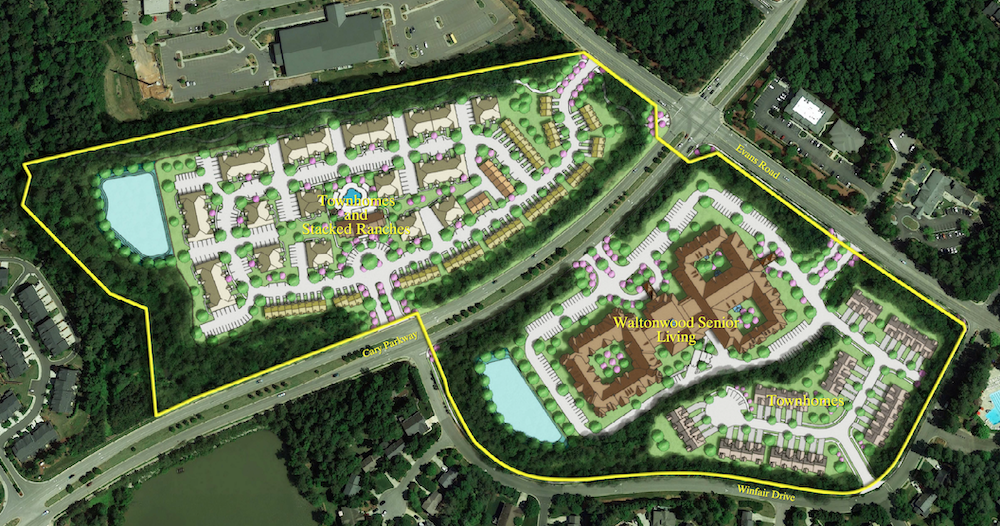In recent years, an increasing number of multifamily real estate developers have entered the senior living space, drawn by the promising demographics and “recession-proof” product. But Singh, a family-owned developer based near Detroit, was ahead of the curve in diversifying into senior living and is now leveraging its capabilities in new ways.
Founded in 1973 with a focus on apartments, Singh started its senior living operating business — Waltonwood Senior Living — in 1987.
“Waltonwood and senior housing have always been part of diversifying our real estate assets,” Singh Project Manager Avi Grewal told Senior Housing News.
It’s a point echoed by Steven Tyshka, director of operations for Waltonwood Senior Living.
“There’s a steep learning curve for competitors that come into the market,” he told SHN. “We have the history and experience and model that is proven.”
Singh’s portfolio includes luxury apartments throughout Oakland and Wayne Counties in Michigan, as well as office and other commercial properties in Michigan and North Carolina, golf clubs and single-family housing developments. Its senior living portfolio consists of 12 operating communities under the Waltonwood banner, in Michigan, Virginia and North Carolina.
The Waltonwood portfolio is expanding, notably through a project taking shape in Cary, North Carolina. There, Singh is creating a mixed-use, intergenerational development that will combine multifamily housing with a senior living community.
‘Not typical to this market’
The Cary project was a long time in the making.
When Singh and Waltonwood established their first community outside of Michigan in 2010, they did so in Cary, a city just west of Raleigh.
Singh also bought a piece of real estate at the corner of Cary Parkway and Evans Road, close to shopping centers, nature trails and office buildings — and only about eight miles away from the Waltonwood building. Because of that proximity, the firm did not consider this site for senior living.
But coming up with a viable use for the land proved challenging, Grewal said. Meanwhile, a site across the street became available, and eventually Singh also acquired a third corner of the intersection.
Now Singh controlled more of the real estate, the demand for senior housing had picked up, and a new vision for this site began to take shape: an intergenerational housing development with shared amenities.
“We thought it would really work,” Grewal said. “We would not only have independent living folks that would transition into assisted living and memory care, we’ll have folks in multifamily that are potentially feeders into independent living down the line.”
The development might also be a place where someone working in the area’s booming economy would rent a home, and then re-locate a parent from elsewhere in the country.

Singh plans to start construction on the multifamily apartments this year.
“The apartments we’re doing are not typical to this market,” Grewal said. “Typically, you’ll see dense apartment communities with parking structures. Here, on 20 acres, we’re doing 212 apartment units that are more townhomes, with every unit having an attached garage and its own entry to the outside.”
The Waltonwood Senior Living building is in the design phase, with construction slated to begin in summer 2020.
Singh is still planning for what will go up on the third corner of the intersection. This is the smallest plot of land, at 2.5 acres. The firm wants to create something that will be conducive to the overall intergenerational vibe, and is mulling active adult-style housing, Grewal said.
While it’s too early to put a dollar figure on the entire development, Grewal estimates that it will run to more than $100 million. Singh does not take any outside equity partners, as the company places a premium on flexibility and long-term holds. It has never sold a Waltonwood building.
The Waltonwood model
Tyshka joined Waltonwood in 2011, after having spent a decade with McLean, Virginia-based Sunrise Senior Living and two years with Lutheran Social Services of Michigan. He was drawn to the family ownership of Waltonwood.
“They want all the team members and associates to be really aligned with their family values and values of the company,” Tyshka said of the family owners. “They’re integrally involved in the ops of the community, and that’s very appealing to our associates. They’ll go in and interact with everyone from executive directors to dishwashers.”
The basic Waltonwood building is in an urban or suburban infill market, serves a high-end clientele, and is between 150 and 250 units. Of those units, about 70% are independent living and 30% are split between assisted living and memory care.
Furnishings and amenities are high-end throughout, which differentiates the brand from competitors who have opulent independent living and less appealing assisted living, Tyshka said.
“As residents transition, they’re not stepping off a cliff,” he said of the Waltonwood experience.
Like other providers across the country, Waltonwood has been grappling with workforce challenges caused by tight labor markets and rising wages. The company responded by doing a culture change initiative last year, based on the acronym FAMILY: feeling valued, anticipating needs, making days memorable, acting with integrity, using laughter and the “yes” mentality.
“I think that’s been helpful, especially for millennials who want to feel like they’re a part of our organization,” Tyshka said.
Waltonwood is also appealing to millennials through technology. It is using OnShift’s Engage tool, which enables associates to communicate with each other regarding scheduling, and is a way for managers to recognize outstanding team members. In dining, Waltonwood has implemented FullCount, a point-of-service platform that enables servers to take orders via iPad, which is pre-loaded with resident info such as dietary restrictions. The company also utilizes Yardi and is introducing some new tools that the electronic health record company is offering.
Offerings such as a CNA certification reimbursement program are also helping boost retention, Tyshka said.
On the health care front, Singh owns home health agencies Oakland Home Care and Oakland Helping Hands in Michigan. The common ownership “carries a lot of weight” for Waltonwood residents who need home health as their care needs escalate, Tyshka noted.
Waltonwood also has partnerships with physician groups and pharmacies, and is exploring partnerships with hospital groups based on reducing readmissions.
New supply has been an issue, particularly in Michigan, putting pressure on occupancy and rates, Tyshka said. However, with Singh ready and able to reinvest in its communities to keep them competitive, and operational initiatives bearing fruit, he is in a confident frame of mind.
“We’re positioning ourselves well,” he said.


